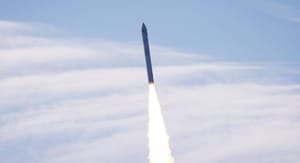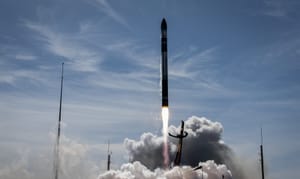
Relativity Space: An Upcoming Industry Titan
The space industry is booming like never before and the next 10 years look very promising. In the next decade we will see humanities (inevitable) return to the Moon, more partially reusable rockets, more science missions, more launch providers, tech demos and more ambitious goals. And one launch provider may just be a promising candidate to leapfrog the industry.

Like any industry, aerospace is hard, complex and it’s very competitive, especially on the launch provider side of things. So predicting the future is hard, but I am quite confident that Relativity Space will be a long term candidate in the industry. However, I would like to let you all know that this is an opinionated argument for why I think Relativity has a long term success potential. So, take things with a grain of salt, because in the end, only time will tell.
With that disclosure out of the way, lets go over Relativity, a future industry titan.
Who is Relativity
Relativity Space is an American Aerospace startup founded in 2015 by Tim Ellis (CEO) and Joryan Noone (Former CTO). Headquartered in Long Beach, California with over 700 employees, Relativity Space is poised to take the market by storm.
They have quite the unique selling point compared to the rest of the competition, which is the fact that they make a majority of their rockets via additive manufacturing. This has a handful of benefits, such as faster build time, stronger end product, less dependency for unique/one off machinery and a less complex design by limiting the need for tens of thousands of parts. Not only do they 3D print their engine hardware, but also bits of the structural design.

A Strong Financial Backing
The hardest part of any aerospace startup is establishing a solid financial backing. Launch provider startups have an immense hill to climb to make profits. Thus making the act of investing into an aerospace company, a risky endeavor. But seemingly this doesn’t worry those supporting Relativity Space financially. According to CNBC, in 2021 during its 5th investment round, Relativity pulled in ~650 million USD at its current valuation of 4.2 billion USD.

While this number is speculative and should be taken with a few grains of salt, this is a very good thing to see. Relativity Space, despite having one test launch under its belt is speculated to be valued at 4.2 billion. For comparison, New Zealand/US based aerospace company, Rocket Lab, the second most flown US launch provider for the past two years, is valued at around 2.7 billion. I again, would take this number with a grain of salt.
However, if these numbers are remotely accurate, that means that Relativity, with just ONE tech demonstration launch is valued nearly double as much as a company with over 40 launches.
Relativity not only has a strong financial backing but they also have at least a dozen launches slated away for their upcoming Terran R rocket. So far, Relativity Space has 9 customers with multiple launches slated as soon as Terran R becomes operational. These launches total in at around 1.8 billion in backlog.
Relativity has more pre-sold launches than anyone else in the industry, bar SpaceX.
"I’m very excited that of the five publicly announced customers for Terran R that make up the $1.2B in contracts, we won 100% of the contracts we went after." - Tim Ellis, Founder of Relativity Space
OneWeb has over 20 launches shelved for Terran R, coming in at an estimated value of $1.2 billion. These launches were planned to launch during 2025, but its more and more likely that we won't see these launches till 2026-27.

As mentioned earlier, Relativity already has multiple customers patiently waiting for Terran R to come online. Most notably OneWeb and Intelsat. These respected members of the industry are already putting their trust in Relativities ability to deliver.
“Relativity has developed an innovative design and production process for the Terran R, which will deliver benefits to Intelsat for years to come.” - Jean-Luc Froeliger, Intelsat Senior Vice President of Space Systems

Terran 1: A Bold Leap Opens A New Door
Terran 1, a Small Satellite Launch Vehicle (SSLV) was Relativity’s first rocket. Powered by 9 Aeon 1, metholox rocket engines. Terran 1 was capable of putting around 1,470kg’s (~3,261lbs) into Low Earth Orbit (LEO). This small sat launcher, started its development journey in 2017 and its maiden and only launch occurred in March of 2023.

While Terran 1 didn’t make it to orbit, it still was a major success for the company. As Terran 1 was 85% 3D printed. The launch was essentially a tech demo with the main goal of surviving “Max-q” which is the maximum aerodynamic pressure experienced during flight. Terran did exactly that, validating the technology Relativity pioneered.
Its maiden launch achieved a handful of firsts, such as the first Western Liquid Methane powered rocket to reach space and the first majorly 3D printed rocket to reach space. Sadly, Terran 1 was shelved after this maiden launch to make room for Terran R development. And while there were many contracts planned for Terran 1, do not fret, as many have already been slated to launch on the upcoming Terran R rocket.
Terran R: The Next Step

Terran R is the next step for Relativity. After a wildly successful maiden launch, Relativity put all hands on deck to roll out Terran R as soon as possible. Terran R is a direct SpaceX Falcon 9 competitor. If we look at the graph below, you can see the capabilities of each rocket, along with estimated cost.

The chart above highlights how Terran R is a direct competitor to Falcon 9, however, this doesn't mean Terran R can just destroy Falcon 9 out of the gates. SpaceX could very well be hiking up the prices because they can and as competitors emerge, they may drop their costs, still making profit but completely shutting out the competition. Terran R also has challenges to face, such as nailing booster reusability.
Despite this, Terran R is quite the rocket system, even though it has been scaled back a bit since its original design. Originally Terran R was going to be a fully reusable rocket that incorporated more 3D printing than currently planned. However, after the Terran 1 launch, Relativity ditched the idea of 3D printing the tanks, opting to only print things like headers and engines. And like most rockets, the initial design is usually overly optimistic and is scaled back as development continues. Full reusability was abandoned to decrease the dev time of Terran R, meaning Relativity could roll it out faster.
It is important to note that Terran R can implement full reusability down the line, but nonetheless it will still be a Falcon 9 competitor out of the gate. Terran R is currently planned to make its debut sometime in 2026. But as the industry has shown time and time again, you should always take these estimates with a few teaspoons of salt, as delays are quite prevalent.
Aeon R
I think it is also important to mention the rocket engines that will power the mighty Terran R. Aeon R is the successor of the Aeon 1 rocket engine, While both of them are Metholox and gas generator rocket engines, they have wildly different performances. Aeon 1 was capable of outputting 23,000 pound-force (100,000 N) of thrust at sea level. While Aeon R is capable of 258,000 pound-force (1,150kN) of thrust.

Recently Aeon R underwent its first test campaign and the pace was rapid. After being delivered to the Stennis Space Center, the Relativity team executed a ten second hot fire of Aeon R. This was the first time a completed Aeon R did a test fire, after 1,000+ induvial components tests. Showing off their mighty pace, the team at Stennis then completed a full Mission Duty Cycle (MDC) just TWO DAYS after this first 10 second hot fire. For reference Aeon 1 had a 56 day intermission between its first integrated engine test to a MDC, while Aeon did it in two days.
Below you can watch the full duration mission duty cycle static fire.
The Aeon R MDC was a 143 second static fire that ran at 70% power and it went flawlessly. To keep adding to this absurd pace it took Relativity just 3 months from their power pack instillation, to completing a MDC.
This crazy pace is very important for Relativities long term success, especially if they want to catch up to SpaceX.

Like its predecessor, Aeon R will be 3D printed. Aeon 1 was around 100 parts due to the use of additive manufacturing, so a similar level of simplicity is to be expected for Aeon R.
Additive Manufacturing, Relativities ”Starlink”
Additive Manufacturing, commonly referred to as “3D printing” is an industry that won’t be going anywhere, anytime soon. Despite Relativity deciding to 3D print less of their upcoming Terran R, they are sill the industry leader when it comes to additive manufacturing in aerospace. As said industry leader, Relativity is in part pioneering technology that will revolutionize the manufacturing side of the aerospace industry.

Currently Relativity claims to own and operate the largest metal 3d printers in the world, referred to as Stargate. This fleet of printers are ushering in a new era in spaceflight and will undoubtedly have a lasting impact. Just by the nature of using the largest (or some of the largest) metal 3d printers, Relativity is pioneering technology such as; sensors and analytics, AI controls and propriety materials.
While it isn't known if Relativity is interested in branching out and using this technology for other industries, that option is very much there. If they were to do this, billions could be generated by technology they pioneered, giving crucial funding to the long term success of the aerospace side of things, supporting Relativities long term goals.
Bringing the Fight to SpaceX

SpaceX has a clear chokehold on the launch industry and this hold won‘t loosen anytime soon. Catching up with SpaceX will be hard, but not impossible and if anyone in the industry can do it, it’s Relativity. Above I went over how Terran R compares to Falcon 9 but that’s only half of the picture. Bringing the fight to SpaceX requires innovation, speed, reliability, financial backing, cadence and a capable rocket architecture.
So while Terran R can bring the fight to Falcon 9 that is completely ignoring the fact that SpaceX also has Falcon heavy AND Starship. While I do think Starship will take a while to be a genuine threat, Relativity have to act fast to close the gap.
The Race to Mars

Mars has been the “crown jewel” so to speak of the space industry. It is humanities next step (bar the Moon). Many private companies and national agencies are all eyeing the red planet. Relativity and its industry partner, Impulse Space are poised to send the first commercial lander to Mars. However, getting there won’t be easy.
The lander, entry and cruise vehicle, all are being designed by Impulse Space. Impulse space was founded in 2021 but the former SpaceX co-founder and CTO of propulsion, Tom Mueller. This Mars mission is only one of a few as according to Barry Matsumori, chief operating officer at Impulse Space, “We will take advantage of the window every 2.2 years and take at least one mission up.”

Relativity and Impulse both want to make commercial missions to Mars routine. NASA has shown interest in this mindset and has already written up a draft highlighting long-term robotic Mars exploration with low cost missions supplied via the commercial sector.
Currently Relativity and Impulse plan on sending a lander to Mars in 2026 after they pushed back the original launch date of 2024 by two years.
It’s important to note, that there is a certain launch window to send payloads to Mars, this is called a ”Transfer Window” which occurs about every two years. This is important to know, because it is unlikely that Terran R or Starship will be capable of sending anything to Mars during the 2024/2026 transfer windows. Thus, it is likely this ”Race to Mars” will be more and more of a race than one may expect. As we could see both companies launch within the same time frame in 2028.
Closing Remarks
In the end it’s quite hard to predict the future, Relativity could leapfrog the industry and match SpaceX in the coming decade(s). Relativity could also go bankrupt in the next decade, or be acquired by another company. The future is in the air and predicting it, especially in aerospace is hard. But I hope you understand why I personally think Relativity is the best candidate out there to match SpaceX in the long term.
No matter what, this friendly rivalry will help push the envelope in the industry, potentially kicking off a mini space race between the two launch providers.
But ultimately, only time will tell.



